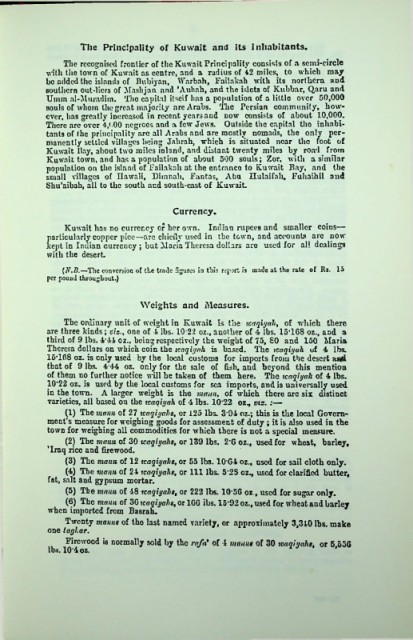Page 399 - 3 Persian Trade rep KUWAIT 1_Neat
P. 399
The Principality of Kuwait and its Inhabitants.
The recognised frontier of the Kuwait Principality consists of a semi-circle
•with tlio town of Kuwait as centre, and a radius of 42 miles, to which may
be added the islands of Bubiyan, IVarbnh, Pailakah with its northern and
southern out-liers of Mashjan and ’Auhah, and the islets of Kubbar, Qaru and
TJmm al-Muradim. Tho capital itself has a population of a little over 50,000
souls of whom the great majority arc Arabs. The Persian community, how
ever, lias greatly increased in recent years and now consists of about 10,000.
There are over 4,<.00 negroes and a few Jews. Outside the capital tho inhabi
tants of the principality arc all Arabs and arc mostly nomads, the only per
manently settled villages being Jahrah, which is situated near the foot of
Kuwait Pay, about two miles inland, and distant twenty miles by road from
Kuwait town, and has a population of about 500 souls; Zor, with a similar
population on the island of Pailakah at the entrance to Kuwait Bay, and the
small villages of Hawaii, Dimnah, Pantas, Abu Hulaifah, Fuhaihil and
Shu’aibah, all to the south and south-east of Kuwait
Currency.
Kuwait has no currency or her own. Indian rupees and smaller coins—
particularly copper pice—are chiefly used in the town, and accounts are now
kept in Indian currency ; but Maria Theresa dollars are used for all dealings
with the desert
(N.B.—The conversion of the trade figures in this report is made at the rate of Es. 15
per pound throughout.)
Weights and Measures.
The ordinary unit of weight in Kuwait is the icaqiyah, of which there
are three kinds; vis., one of 1 lbs. 10 22 oz., another of 4 lbs. 15*168 oz., and a
third of 9 lbs. 4*44 oz., being respectively the weight of 75, £0 and 150 Maria
Theresa dollars on which coin the icaqiyah is based. The icaqiyah uf 4 lbs.
15*108 oz. is only used by the local customs for imports from the desert aafd
that of 9 lbs. 4 44 oz. only for the sale of fish, and beyond this mention
of them no further notice will be taken of them here. The icaqiyali of 4 lbs.
10*22 oz. is used by the local customs for sea imports, and is universally used
in the town. A larger weight is the maun, of which there are six distinct
varieties, all based on the icaqiyah of 4 lbs. 10*22 oz., ms. :—
(1) The maun of 27 icaqiyah8, or 125 lbs. 3*94 oz.; this is the local Govern
ment’s measure for weighing goods for assessment of duty ; it is also used in the
town for weighing all commodities for which there is not a special measure.
(2) The maun of 30 icaqiyahs, or 139 lbs. 2*C oz., used for wheat, barley,
’Iraq rice and firewood.
(3) The matin of 12 tcaqiyahs, or 55 lbs. 10*64 oz., used for sail cloth only.
(4) The maun of 24 icaqiyahs, or 111 lbs. 5*2S oz., used for clarified butter,
fat, salt and gypsum mortar.
(5) Tbe maun of 48 icaqiyahs, or 222 lbs. 10*56 oz., used for sugar only.
(6) The maun of 3G icaqiyahs, or 106 ibs. 15*92 oz., used for wheat and barley
when imported from Basrah.
Twenty matins of tho last named variety, or approximately 3,340 lbs. make
one tayl.ar.
Firewood is normally sold by the rofa' of 4 mams of 30 toaqiyahs, or 5.55G
lbs. 10*4 oz.

